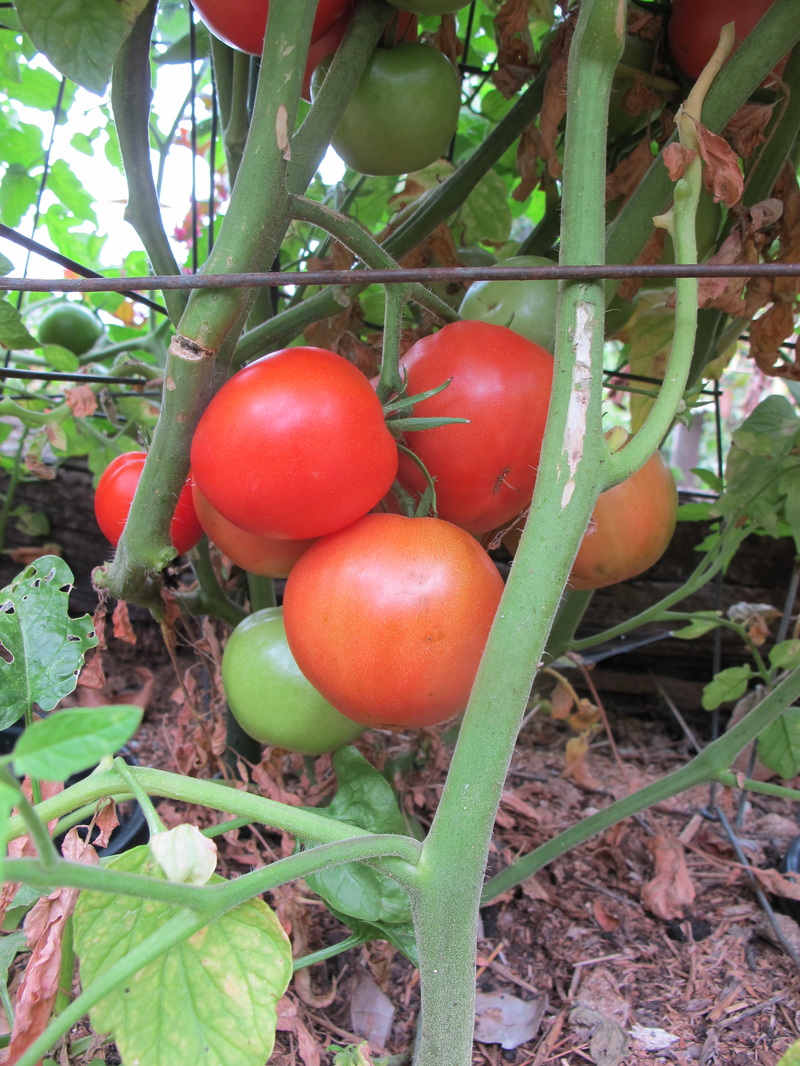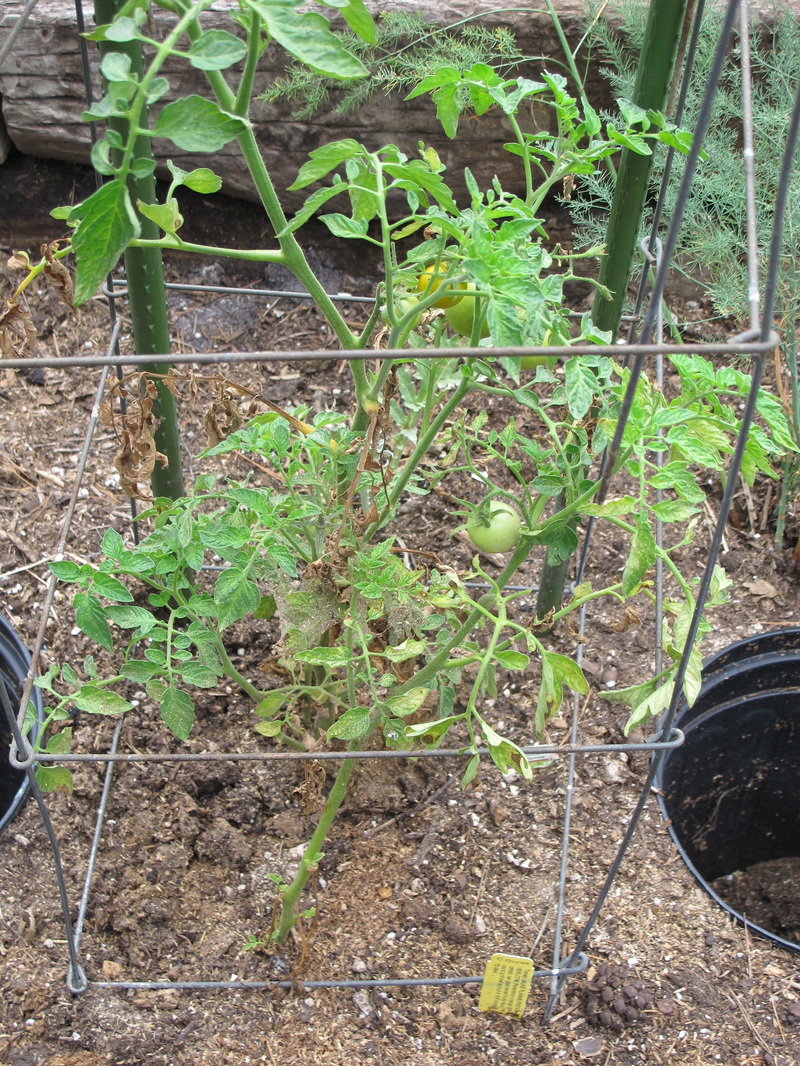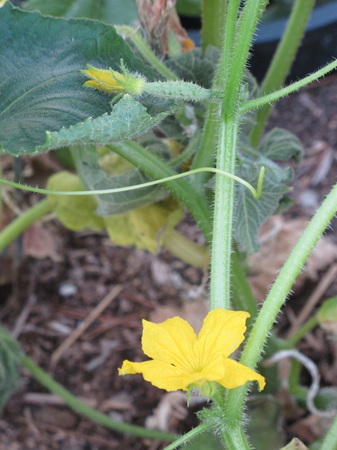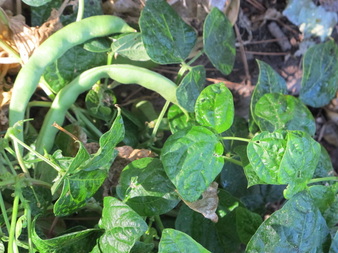| | Since my last blog in mid-May, I’ve returned back home to a glorious set of Sungold, Carmelo, and Celebrity tomatoes, but some other wimpy tomato plants, cucumbers that’d begun to set fruit, and bean volunteers that were in full set. Hurray for my 4”-thick mulch and heavy watering prior to leaving! It’s always a concern, when I go away for more than two weeks, what the weather will be and how the plants will fare. As it turned out, both well and not so well. Here’re some of my thoughts on my garden and other gardeners’ queries that occur every year. Tomatoes If your plants are wimpy like the one in the third photo, even though the soil is moist, the plant is starving. Fertilize it with a “balanced” fertilizer – that has equal amounts of each N, P, and K – like 5-5-5 – or a “complete” fertilizer with approximately the same numbers of each N, P, and K – like 7-4-5. Then water it in immediately. You want to provide all of the nutrients to the plant so hopefully it’ll recouperate sufficiently to provide blossoms and fruit. And resolve that you’ll incorporate more balanced fertilizer into the soil before your next crop! If your plants are brilliant green and bushy but have no blossoms or fruit, they’re too well fed with nitrogen and/or watered – too “happy” to proceed with the business of reproduction. Let them starve and dry out for a while. When you do see blossoms, shake the bush to help them set fruit, since they’re self-pollinating. Be aware that air temperatures over 85 for more than a week will deter blossoming until temperatures are lower for a good two weeks! This usually means July, but this coming weekend threatens to be over 100 degrees, so who knows what temperatures will be following that. As plentiful as your tomato set has begun, be aware that “determinate” varieties (like Celebrity and Carmelo) will bear all their fruit within a couple of weeks and then die, so plant another set of seedlings now. It may be tricky finding healthy seedlings that are less than six inches tall, but more mature plants just won’t successfully transplant since our hot weather is almost upon us and they’ll be too stressed to establish themselves and then thrive. In any case, remove blossoms and fruit until the plant is a full two feet tall and obviously doing well – you want the plant’s energies to go into establishing itself for lots of fruit later, rather than a couple of fruit now that will deplete the plant completely. Squash If first blossoms fall off, chances are they’re the male ones (with just a straight stem below the blossom). Female ones (with the tiny squash at the base of the flower) will also appear shortly and probably set just fine. As female blossoms appear, sow another set of seeds for new plants that will provide continuous fruit after the first set of plants finish. Cucumbers If you didn’t provide trellises when you first planted the seeds, do so now as best you can, so fruits stay off of the soil – dry and away from munching creepy-crawlers. As with squash, as blossoms appear, sow another set of seeds to provide continuous fruit after the first set finish. Pea Vines (dried out till they’re crispy) Instead of removing spent pea vines completely by pulling them out, I clip them at soil level so their “nitrogen fixer” roots will remain in the soil to decay in place, leaving that nitrogen for later crops. And irrigation water will follow the root pathways down into the soil. Beans Since the volunteer beans that escaped my harvesting last year have shown me that I’ve waited too long to sow them this year – since they’re blossoming and already set fruit -- I’ll do so now for an intentional crop. I plant beans in the same bed where I’d grown peas overwinter, to continue the succession of providing nitrogen to the soil. Bush beans will bear like “determinate” tomatoes – mostly all at once and then die. Pole beans will bear over a longer period of time. I prefer planting “stringless” types so I don’t have the nuisance of trying to distinguish them once I’ve harvested them all, either before or after cooking – I do hate “finding” a string to pull out of my teeth once I’ve chewed it! |
|
3 Comments
6/27/2016 03:25:19 pm
Wow - very informative! Didn't know that about determinate tomatoes and bush beans! Does growing them in a smaller container stretch out the time the plant will bear fruit? I am thinking of those tomatoes they market as patio tomatoes.
Reply
Hi, Xochitl -
Reply
Leave a Reply. |
Categories |






 RSS Feed
RSS Feed